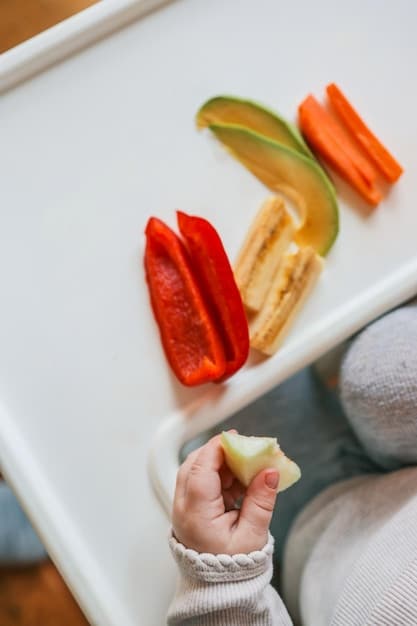Baby-Led Weaning for Picky Eaters: The Complete Guide

Baby-led weaning (BLW) can be a game-changer for introducing solids to picky eaters, offering a flexible, enjoyable, and empowering approach that encourages exploration of textures and flavors from the start.
Is your little one turning their nose up at every spoonful? Introducing solids can be a stressful time, especially if you’re worried about creating a picky eater. Baby-led weaning for picky eaters offers a unique, hands-on approach that might just be the solution you’ve been searching for.
Understanding Baby-Led Weaning and Picky Eating
Baby-led weaning, or BLW, is all about letting your baby take the lead when it comes to starting solids. Instead of spoon-feeding purees, you offer your baby appropriately sized and textured pieces of soft foods, allowing them to explore and self-feed.
But what happens when your little one is already showing signs of pickiness? That’s where understanding both BLW and picky eating comes in. Let’s dig into the basics of BLW and how it can potentially help mitigate picky eating habits.
What is Baby-Led Weaning?
Baby-led weaning is an approach where babies are introduced to solid foods by self-feeding finger foods from the very beginning, typically around six months of age. This method contrasts traditional weaning, which starts with purees and gradually introduces textures.
The core principle of BLW is to allow babies to explore food at their own pace, develop their fine motor skills, and learn to regulate their intake based on their hunger cues. This hands-on approach can foster a positive relationship with food early on.
Why Can Some Babies Become Picky Eaters?
Picky eating can stem from various factors, including genetics, temperament, and exposure to different foods. Some babies are naturally more cautious about new experiences, including trying new foods. Repeatedly offering a limited range of foods can also reinforce picky eating habits.
Additionally, control dynamics during feeding can contribute to pickiness. Forcing or pressuring a child to eat can create negative associations with meal times, leading to resistance and further pickiness. Recognizing these potential pitfalls can help parents navigate feeding challenges more effectively.
Baby-led weaning addresses some of these potential issues by empowering babies to explore food independently, reducing the likelihood of power struggles and increasing their comfort with a variety of textures and tastes.
Ultimately, understanding the interplay between BLW and the potential for picky eating can help parents approach feeding with patience and flexibility, fostering a positive and healthy relationship with food for their little ones.
Benefits of BLW for Potentially Picky Eaters
One of the most appealing aspects of baby-led weaning is its potential to help prevent or reduce picky eating. By engaging multiple senses and promoting autonomy, BLW can foster a more positive and exploratory relationship with food from the start.
So, what are the specific benefits of BLW for potentially picky eaters? Let’s delve into the advantages of this approach.

Encourages Exploration and Sensory Development
BLW allows babies to explore foods with all their senses – sight, smell, touch, and taste. Handling different textures and shapes encourages sensory development, which can make them more accepting of new foods. This early exposure can reduce neophobia, the fear of new things.
Offering a variety of colors, shapes, and textures from the start can pique their curiosity and make meal times more engaging. The freedom to touch, squish, and examine food helps babies become more comfortable with different food properties.
Empowers Babies to Control Their Intake
Unlike traditional spoon-feeding, BLW lets babies decide how much and how quickly they want to eat. This control helps them tune into their natural hunger and fullness cues, which can prevent overeating and supports a healthy relationship with food. By letting babies self-regulate, you’re honoring their autonomy.
Allowing babies to manage their own food intake can also reduce power struggles. When babies feel in control, they are less likely to resist eating, making meal times more peaceful and positive for everyone involved.
Exposure to a Wider Variety of Foods Early On
BLW often involves introducing babies to a wide variety of foods from an early age. Since babies eat what the family eats (in an age-appropriate format), they become familiar with different flavors, ingredients, and cultural dishes. This extensive exposure can broaden their palate and make them more open to trying new foods as they grow.
From the start, babies can participate in family meals, fostering a sense of inclusion and creating a more relaxed dining atmosphere. The early exposure to diverse flavors and textures can lay the foundation for more adventurous eating habits in the future.
Incorporating BLW can create a more positive and exploratory environment for babies, encouraging them to try new things and develop a broader palate. This approach can lead to a more relaxed and enjoyable introduction to solids and potentially reduce the risk of picky eating habits later on.
Essential Guidelines for Safe Baby-Led Weaning
While baby-led weaning holds many benefits, safety must be a top priority. Understanding and following key guidelines is crucial to ensuring a positive and safe experience for your little one.
Here’s what you need to know to practice BLW safely and confidently:
Ensure Baby Can Sit Upright and Has Good Head Control
Before starting BLW, ensure that your baby can sit upright unsupported and has good head control. These milestones indicate readiness for self-feeding and minimize the risk of choking. Good posture helps with safe swallowing and reduces the likelihood of food blocking the airway.
If your baby is struggling to sit up or control their head movements, wait a little longer before introducing solids. Every baby develops at their own pace, so it’s important to respect their individual timeline.
Offer Foods in Safe Shapes and Sizes
Cut foods into sizes and shapes that are easy for your baby to grasp and self-feed. Ideal shapes are long strips or finger-like pieces, approximately the size of an adult finger. Avoid small, round foods like grapes or cherry tomatoes, unless they are quartered.
Preparing food in safe shapes and sizes reduces the risk of choking. Soft-cooked vegetables, fruits, and meats cut into strips are excellent options for early BLW.
Always Supervise Meal Times
Never leave your baby unattended during meal times. Always supervise them to ensure they are eating safely. Being present allows you to monitor their feeding and provide assistance if needed.
Supervision is crucial for early feeding experiences. By being attentive and responsive, you can help your baby develop confidence and skills in self-feeding.
- Preparation: Cook foods until they are soft enough to be easily mashed between your fingers, ensuring they are safe for your baby to eat.
- Age: Start introducing solids around six months when your baby shows signs of readiness, such as sitting upright and showing interest in food.
- Choking vs. Gagging: Understand the difference between gagging (a normal reflex) and choking (a medical emergency). Educate yourself on how to respond to each situation.
Taking these precautions can create a more relaxed and confident approach to introducing solids via BLW. Safety should always come first, allowing you and your baby to enjoy this exciting milestone.
Addressing Common Concerns and Challenges
Transitioning to baby-led weaning can bring forth various concerns and challenges, especially when dealing with a potentially picky eater. Addressing these issues proactively can ensure a smoother, more positive experience for both you and your baby.
Let’s explore how to tackle common concerns and challenges encountered during baby-led weaning.
Concern: Gagging
Gagging is a normal reflex that protects your baby from choking. It’s often mistaken for choking, but it’s a natural way for babies to learn how to manage food in their mouths. When a baby gags, they typically push the food forward with their tongue.
Understanding the difference between gagging and choking is essential. Choking is silent and requires immediate action (like back blows and chest thrusts). Gagging, on the other hand, is noisy and usually resolves itself.
Challenge: Messy Meal Times
Messiness is an inherent part of baby-led weaning. Babies explore food with their hands, which can result in food being smeared all over the place. Embrace the mess as part of their learning process.
To manage the mess, use a large floor mat under the highchair and dress your baby in clothes that you don’t mind getting stained. Letting go of the need for a perfectly clean mealtime can make the experience more enjoyable for everyone.

Concern: Nutrient Intake
Some parents worry that their baby might not be getting enough nutrients through BLW. It’s important to offer a variety of nutrient-dense foods to ensure they are meeting their nutritional needs.
Iron-rich foods, such as well-cooked meat, lentils, and fortified cereals, are particularly important. Consult with a pediatrician or registered dietitian to address any specific concerns about nutrient intake.
- Variety: Offer a wide range of foods to ensure your baby is exposed to different nutrients and flavors.
- Patience: Be patient and persistent. It can take multiple attempts for a baby to accept a new food, especially if they are prone to picky eating.
- Positive Reinforcement: Create a positive and relaxed mealtime environment. Avoid pressuring your baby to eat, as this can lead to negative associations with food.
Facing BLW with a little knowledge and preparation can help you navigate these challenges with confidence. Remember, it’s all about creating a positive, exploratory experience with food for your little one.
Tips for Introducing New Foods to Picky Eaters
Introducing new foods to a potentially picky eater through baby-led weaning requires patience, creativity, and a strategic approach. Making the experiences positive and pressure-free can make a big difference.
Here are some helpful tips to encourage your baby to try new flavors and textures:
Start with Familiar Foods
Begin by offering new foods alongside familiar favorites. This can make the new food less intimidating and more appealing. Introducing a new vegetable alongside a fruit your baby already loves, for instance, can ease the transition.
Familiar foods can act as a bridge, helping your baby feel more comfortable with the meal as a whole.
Make it Fun and Interactive
Turn meal times into an interactive game. Let your baby help prepare the food (in an age-appropriate way), talk about the colors and shapes of the food, and make funny faces while trying new things. Involving them in the process can increase their interest and willingness to try new items.
Fun and engaging meal times can reduce anxiety and encourage exploration.
Offer Foods in Different Forms
Sometimes, all it takes is a different preparation method to make a food more appealing. If your baby doesn’t like steamed broccoli, try roasting it or serving it raw as small, tender florets. Experiment with different textures and presentations to find what works best.
Varied preparations can highlight different flavors and textures, increasing the likelihood of acceptance.
Being patient and consistent with your approach can help your baby gradually expand their palate and develop a more adventurous attitude towards food.
Conclusion
Baby-led weaning can be a rewarding journey when approached with patience, understanding, and a focus on creating positive experiences. By empowering your baby to explore food at their own pace, you can help foster a healthy and adventurous relationship with eating that lasts a lifetime.
| Key Point | Brief Description |
|---|---|
| 👶 BLW Basics | Allowing babies to self-feed soft finger foods from around 6 months. |
| 🍽️ Benefits | Encourages exploration, empowers self-regulation, exposes to variety. |
| ⚠️ Safety First | Ensure upright sitting, safe shapes, supervision, and soft food texture. |
| 🍎 Picky Eating Tips | Start with familiar foods, make it fun, and offer different food forms. |
Frequently Asked Questions (FAQs)
▼
You can typically start BLW around six months when your baby can sit upright, has good head control, and shows an interest in food. Every baby is different, so consult with your pediatrician.
▼
Soft-cooked vegetables like broccoli, carrots, and sweet potatoes, as well as soft fruits like avocado, banana, and peach slices, are excellent choices for starting BLW.
▼
Continue to offer breast milk or formula while introducing solids. Monitor your baby’s weight gain, diaper output, and overall growth. Trust their ability to self-regulate their intake.
▼
Don’t give up! It can take multiple attempts for a baby to accept a new food. Offer the food again another day without pressure. Keep meal times positive and relaxed.
▼
Yes, BLW can be safe when done correctly. Ensure your baby is developmentally ready, offer foods in safe shapes and sizes, and always supervise meal times to minimize any risks.
Conclusion
Baby-led weaning for picky eaters doesn’t have to be a daunting task; with the right approach and lots of patience, you can transform meal times into enjoyable learning experiences for your little one. Remember to stay informed, be patient, and trust your baby’s instincts as they explore the wonderful world of food.





